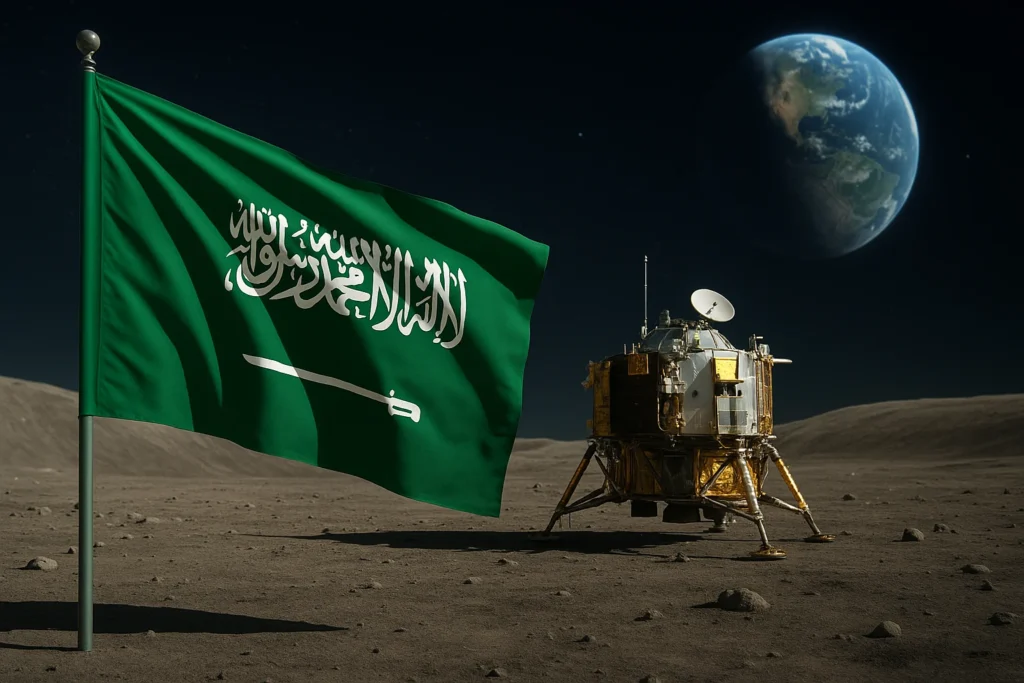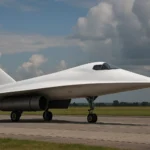For decades, the name Saudi Arabia has been synonymous with vast oil reserves, a bedrock of the global energy economy. But as the world shifts and new frontiers open, the Kingdom is charting an audacious course far beyond the desert sands. Under its ambitious Vision 2030, Saudi Arabia is rapidly diversifying its economy, pouring significant resources into innovation, technology, and, crucially, space. While no specific lunar mining mission has been formally unveiled, the nation’s strategic moves, robust investments, and participation in international space dialogues signal a clear and compelling ambition: to position itself as a key player in the nascent, multi-trillion-dollar space economy, with an eye firmly on the Moon’s vast, untapped resources, including the tantalizing prospect of Helium-3.
This isn’t just about a flag on the lunar surface; it’s about a long-term strategic play, leveraging existing expertise in resource extraction to explore a new dimension of wealth. The journey from terrestrial oil to cosmic minerals is complex, fraught with challenges, yet illuminated by the promise of clean energy and unparalleled geopolitical influence. Saudi Arabia’s proactive engagement in the burgeoning space race is a clear statement: the Kingdom is not just observing the future of resources; it intends to shape it, from the Earth’s depths to the lunar regolith.
Vision 2030: Fueling a New Frontier Beyond Hydrocarbons
At the heart of Saudi Arabia’s bold push into space lies Vision 2030, the Kingdom’s blueprint for economic and social transformation. Launched in 2016, this ambitious plan aims to move Saudi Arabia away from its historical reliance on oil, fostering a thriving, diversified economy driven by knowledge and innovation. The space sector has emerged as a crucial pillar in this grand strategy.
The establishment of the Saudi Space Commission (SSA) in 2018 marked a definitive commitment, providing the institutional framework for the Kingdom’s cosmic aspirations. The SSA is tasked with developing a national space strategy, fostering research and development, building human capital, and promoting international collaboration.
Recent milestones vividly illustrate this commitment:
- Astronaut Missions: In May 2023, Saudi Arabia made history by sending its first two astronauts, Rayyanah Barnawi (the first Saudi woman in space) and Ali AlQarni, to the International Space Station (ISS) on Axiom Mission 2. This mission wasn’t just symbolic; it involved scientific experiments and underscored Saudi Arabia’s rapid advancements in human spaceflight.
- Artemis Accords Signatory: Saudi Arabia became the 21st country to sign the Artemis Accords, a set of non-binding principles for peaceful and sustainable lunar exploration and resource utilization, led by the United States. This signature is a significant geopolitical signal, aligning Saudi Arabia with nations committed to transparent and responsible space operations, including the potential for lunar mining.
- Strategic Investments: The Public Investment Fund (PIF), Saudi Arabia’s sovereign wealth fund, is channeling substantial capital into space-related ventures. A prime example is the launch of Neo Space Group in 2024, the Kingdom’s first major foray into satellite and space industries, aiming to build domestic capabilities in satellite manufacturing and space services.
- Center for Space Futures: In partnership with the World Economic Forum, Saudi Arabia is set to open a “Center for Space Futures” in Fall 2024. NASA Administrator Bill Nelson highlighted that this center will bring together commercial and government entities to “send a mission to the moon and build a $2 trillion global space economy by 2035.” While not explicitly a “mining mission,” it clearly indicates a concrete lunar objective and a focus on economic development from space.
These concerted efforts highlight that Saudi Arabia is not just venturing into space; it is strategically building an entire ecosystem to support long-term ambitions, including the potential for space resource utilization.
The Lunar Lure: Why the Moon Matters for Future Resources
For centuries, the Moon was primarily a symbol of romance, a celestial body for distant observation. Then, it became a destination for scientific exploration. Now, with advancements in technology and a growing demand for sustainable resources on Earth and in space, the Moon is increasingly seen as a vast reserve of valuable materials.
The Moon’s geological history and lack of a thick atmosphere mean that its surface, or regolith, has been continuously bombarded by solar winds and micrometeorites for billions of years. This process has deposited a variety of elements and isotopes not readily available on Earth in extractable quantities, or those that are extremely difficult and energy-intensive to produce here.
Key resources potentially available on the Moon include:
- Water Ice: Primarily located in permanently shadowed regions near the lunar poles, water ice is invaluable. It can be used for drinking, life support for lunar habitats, and, critically, split into hydrogen and oxygen to produce rocket fuel. This is vital for sustaining long-duration missions and establishing a future “gas station” in space for journeys to Mars and beyond.
- Rare Earth Elements: These are critical for modern electronics, renewable energy technologies, and many high-tech industries. While found on Earth, lunar deposits could offer a new, independent supply.
- Helium-3 (³He): This particular isotope is generating significant excitement and is often highlighted when discussing lunar mining ambitions.
The Moon is no longer just a scientific outpost; it’s being redefined as a potential cosmic quarry, a stepping stone to deeper space, and a crucial component of a future space-based economy. For nations like Saudi Arabia, looking to diversify and lead in new industries, the allure of lunar resources is undeniable.
The Promise of Helium-3: A Futuristic Fusion Fuel
Among the most talked-about resources on the Moon, Helium-3 stands out as a “holy grail” for future energy. It’s a non-radioactive isotope of helium with two protons and one neutron, incredibly rare on Earth. However, thanks to billions of years of bombardment by solar winds, Helium-3 is thought to be relatively abundant in the Moon’s regolith.
Why is Helium-3 so appealing?
- Clean Nuclear Fusion: Helium-3 is considered an ideal fuel for aneutronic nuclear fusion. Unlike traditional nuclear fission (which generates radioactive waste) or even deuterium-tritium fusion (which produces energetic neutrons, leading to radioactive byproducts), a deuterium-Helium-3 fusion reaction would produce almost no radioactive waste. It promises a clean, safe, and highly efficient energy source.
- High Energy Yield: A small amount of Helium-3 could produce a vast amount of energy. Estimates suggest that just one metric ton of Helium-3, if successfully used in a fusion reactor, could power a major city for a year. The Moon is believed to contain millions of tons of this isotope.
- Terrestrial Scarcity: On Earth, Helium-3 is primarily a byproduct of tritium decay (a radioactive isotope used in nuclear weapons and some scientific applications), making it extremely rare and expensive to produce. This scarcity makes lunar sources exponentially more attractive for a potential fusion economy.
The Current Reality:
It’s important to note that large-scale nuclear fusion power plants using Helium-3 are still in the experimental stages and decades away from commercial viability. The technology to initiate and sustain a Deuterium-Helium-3 fusion reaction at scale is immensely complex. Furthermore, the technology to efficiently extract Helium-3 from the lunar regolith and transport it back to Earth is also in its infancy.
Despite these significant technological hurdles, the immense potential of Helium-3 as a clean energy source for future generations makes it a highly coveted resource. Nations and private companies worldwide are investing in both fusion research and lunar extraction technologies, positioning themselves for a future where lunar Helium-3 could literally power the planet.
From Terrestrial Extraction to Cosmic Resources: A Natural Transition?
Saudi Arabia’s core economic strength has historically been its unparalleled expertise in extracting, processing, and distributing hydrocarbons – oil and natural gas. This deep-rooted experience in large-scale resource management on Earth might provide a unique advantage and perspective as the Kingdom looks towards lunar resource utilization.
While the environments are vastly different, the fundamental principles of resource extraction share some common ground:
- Geological Surveying: Identifying high-concentration deposits.
- Drilling/Excavation: Mechanically accessing the resource.
- Processing: Separating the desired material from waste.
- Transportation: Moving the extracted resource.
- Large-Scale Project Management: Coordinating complex operations, often in harsh environments.
Saudi Arabia’s national oil company, Aramco, has mastered these processes on a colossal scale. While lunar mining presents unique challenges (vacuum, extreme temperatures, lunar dust, low gravity), the engineering mindset, project management capabilities, and a workforce accustomed to operating in challenging conditions could be transferable assets.
The Kingdom’s participation in “space mining dialogues,” as publicly discussed by the Saudi Space Agency, particularly with nations like the U.S., Japan, and Luxembourg (countries at the forefront of space resource legislation and technology), is a strong indicator of this interest. It shows a proactive approach to understanding the technical, legal, and economic frameworks necessary for future lunar resource extraction. While they haven’t announced a specific mission, their engagement suggests a strategic intent to leverage their terrestrial resource-management experience in the cosmic arena. This makes Saudi Arabia’s pursuit of lunar resources a logical, albeit ambitious, extension of its economic identity.
Building the Ecosystem: Partnerships and Infrastructure for Space Ambitions
Saudi Arabia understands that becoming a major player in the space economy requires more than just launching rockets; it demands a robust, integrated ecosystem of technology, talent, and partnerships. The Kingdom is rapidly investing in all these areas to support its long-term lunar ambitions.
- The Saudi Space Commission (SSA): Beyond strategy, the SSA is actively nurturing a domestic space industry, encouraging research and development, and fostering collaborations between academia, industry, and international partners.
- Neo Space Group (NSG): Launched by the PIF, NSG represents a significant step towards developing indigenous capabilities. Its focus on satellite manufacturing and space services provides critical infrastructure for future lunar and deep-space missions. Building satellites, ground stations, and data processing capabilities are all essential components for any sophisticated space operation, including resource prospecting and communication for lunar missions.
- Human Capital Development: Vision 2030 places a strong emphasis on empowering Saudi youth through education and training. Programs are being developed to cultivate a new generation of Saudi scientists, engineers, and entrepreneurs specializing in aerospace and space sciences. Sending Saudi astronauts to the ISS serves as a powerful inspiration for young people to pursue STEM fields, building the talent pipeline for future lunar endeavors.
- International Collaborations: Beyond the Artemis Accords, Saudi Arabia is actively seeking and forging partnerships with leading space agencies and private companies worldwide. This open approach allows the Kingdom to gain access to cutting-edge technologies, share expertise, and collaboratively address the immense challenges of space exploration and resource utilization. The planned Center for Space Futures in collaboration with the World Economic Forum is designed to be a hub for such public-private discussions and technology acceleration.
This comprehensive approach demonstrates that Saudi Arabia is not just making aspirational statements. It is laying the groundwork, brick by brick, for a future where it can actively participate in, and potentially lead, in areas like lunar exploration and resource development. The Kingdom is creating the necessary intellectual, industrial, and diplomatic infrastructure to support its long-term “resource play” in space.
The Global Race for Lunar Riches: Setting the Stage
Saudi Arabia’s burgeoning interest in lunar resources unfolds against a backdrop of a rapidly accelerating global space race, where several nations and private entities are already making significant strides in lunar exploration and even preliminary resource extraction technologies. This dynamic environment shapes Saudi Arabia’s strategic approach.
- United States (Artemis Program): NASA’s Artemis program aims to return humans to the Moon by the mid-2020s and establish a sustainable long-term presence. A key pillar of Artemis is In-Situ Resource Utilization (ISRU), particularly extracting water ice from the lunar poles, which can be converted into rocket fuel and life support. U.S. companies like Intuitive Machines and Astrobotic are already sending commercial landers to the Moon, often carrying ISRU payloads. Private firms like Interlune are specifically prototyping Helium-3 extraction equipment, aiming for deployment by the early 2030s.
- China (Chang’e Program): China has achieved remarkable success with its Chang’e robotic lunar missions, including sample returns from the near side and the historic first landing on the far side. China also has long-term plans to establish a permanent lunar base and has openly discussed interest in lunar resources, including Helium-3.
- India (Chandrayaan Program): India’s Chandrayaan-3 successfully soft-landed near the lunar south pole in 2023, a region believed to be rich in water ice. ISRO has also expressed interest in lunar resource utilization.
- Europe and Japan: The European Space Agency (ESA) and Japan Aerospace Exploration Agency (JAXA) are actively involved in lunar exploration, developing technologies for precision landing, robotics, and future resource prospecting, often in collaboration with NASA’s Artemis program.
- Private Companies: A growing number of private companies worldwide are at the forefront of developing lunar mining technologies, from robotic excavators to resource processing plants. They often aim to be the first to demonstrate commercially viable resource extraction.
Saudi Arabia’s entry into this competitive but collaborative landscape is strategic. By focusing on ecosystem development, international partnerships, and exploring the potential for its terrestrial resource expertise to be applied to lunar ISRU, the Kingdom is positioning itself to be a significant player, not just an observer, in this exciting new chapter of space exploration and economic development.
Challenges on the Lunar Horizon: A Steep Ascent
While the allure of lunar resources, especially Helium-3, is immense, the path to successful extraction and utilization is fraught with immense challenges. Saudi Arabia, like all other aspiring lunar powers, faces a steep ascent.
- Technological Hurdles:
- Extreme Environment: The Moon’s vacuum, extreme temperature swings (-173°C to 127°C), abrasive lunar dust, and low gravity create formidable engineering challenges for machinery and human operations.
- Energy Requirements: Extracting and processing resources on the Moon will demand significant power, likely from solar arrays or even small lunar nuclear reactors, which are still under development.
- Autonomous Operations: Due to communication delays and the high cost of human presence, lunar mining operations will likely rely heavily on highly autonomous robotics, requiring sophisticated AI and machine learning.
- Helium-3 Specific Challenges: Helium-3 is embedded in the top few meters of lunar regolith in very small concentrations (a few parts per billion). This means vast amounts of lunar soil must be excavated, heated to hundreds of degrees Celsius, and then processed to extract tiny quantities of the gas. The energy balance for such an operation is a critical factor yet to be fully proven.
- Economic Viability: The enormous cost of developing, launching, and operating lunar mining infrastructure currently outweighs the immediate economic benefits. For Helium-3, its economic viability hinges entirely on the successful commercialization of fusion power on Earth, which remains decades away. This makes lunar Helium-3 mining a high-risk, long-term investment.
- Legal and Governance Frameworks: While the Artemis Accords provide a framework for resource utilization, the legalities of property rights and the commercialization of space resources are still evolving and subject to international debate. The 1967 Outer Space Treaty forbids national appropriation of celestial bodies, but the interpretation for resource extraction is contentious.
- Logistics and Supply Chain: Establishing a robust supply chain to transport machinery to the Moon, maintain it, and then transport extracted resources back to Earth (or process them in space) presents logistical challenges on an unprecedented scale.
Saudi Arabia’s strategy acknowledges these hurdles. By focusing on foundational investments, building partnerships, and fostering domestic talent, the Kingdom is preparing for a long game, understanding that patience and sustained effort will be key to unlocking the Moon’s potential.
Saudi Arabia’s Vision: A Long-Term Cosmic Play
The narrative of Saudi Arabia’s journey from an oil-rich nation to a potential space powerhouse is compelling. While specific timelines for a dedicated lunar mining mission are yet to be revealed, the Kingdom’s strategic investments, high-level discussions, and proactive participation in global space initiatives clearly articulate its long-term vision.
This isn’t merely about technological prowess; it’s about a fundamental transformation of national identity and economic foundation. By diversifying into high-tech sectors like space, Saudi Arabia aims to create new industries, generate high-skilled jobs for its youth, and establish itself as a global leader in innovation. The pursuit of lunar resources, including the visionary prospect of Helium-3, represents the ultimate extension of this ambition.
The “Center for Space Futures” and investments through the PIF into companies like Neo Space Group are tangible steps in building the infrastructure and human capital necessary for deep space endeavors. The signing of the Artemis Accords reflects a commitment to international collaboration, acknowledging that the future of space exploration and resource utilization will be a shared human endeavor.
In the grand tapestry of human exploration, Saudi Arabia is weaving a new thread. From the vast energy fields beneath its deserts to the tantalizing resources on the Moon, the Kingdom is demonstrating a powerful foresight. The journey will be challenging, but the aspiration is clear: to be at the forefront of the next great resource frontier, proving that the pursuit of prosperity can extend far beyond Earth’s gravity, reaching for the very stars.



